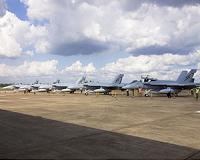| . |  |
. |
Fort Worth TX (SPX) Apr 22, 2010 The seventh Lockheed Martin F-35 Lightning II flight test aircraft took to the skies for the first time, with the overall objective of validating the F-35A conventional takeoff and landing (CTOL) variant's weapons suite. The jet, known as AF-2 and piloted by Lockheed Martin F-35 Test Pilot Jeff Knowles, took off at 5:57 p.m. CDT from Naval Air Station Fort Worth Joint Reserve Base and flew for 1 hour. "The first flight of AF-2 is a significant achievement for the F-35 program, the U.S. Air Force and our international partners who will operate the F-35A," said James "Sandy" Sandstrom, Lockheed Martin's F-35 U.S. Air Force program manager. "This aircraft is configured to test and verify the multiple weapons loads that will deliver 5th generation combat capability to the warfighter." AF-2 will be used to verify the F-35A's ability to carry both internal and external weapons throughout the required flight envelope. The jet is also the first F-35 to have the internal GAU-22/A 25-millimeter gun system installed. The system, featuring a four-barrel Gatling gun which fires at a rate of 3,000 rounds per minute, is made by General Dynamics Armament and Technical Products in Burlington, Vt. Gun testing on AF-2 will be used to confirm predictions of gun vibration, acoustic and recoil loads with the aircraft and various weapons. Additionally, the aircraft will be used to confirm vibro-acoustic loads with the weapons-bay doors open and closed with various weapon configurations. The measurements will validate the structural design of the jet, and provide evidence of the F-35A weapons' compatibility with gunfire and weapons-bay environments. Supersonic launch of internal weapons, including maximum-speed (Mach 1.6) launch of internal air-to-air missiles, is a feature of all F-35s. An internal-weapons-only configuration is used when Very Low Observable stealth is required to complete a mission. When VLO stealth is not required, more than 15,000 pounds of additional ordnance can be loaded onto six external pylons. F-35 test aircraft are supported by the F-35 Autonomic Logistics Information System (ALIS) and managed by the Lockheed Martin F-35 Sustainment Operations Center in Fort Worth. ALIS is the worldwide support system reporting and recording the prognostics and health of all F-35s around the globe to ensure mission readiness. The F-35 Lightning II is a 5th generation fighter, combining advanced stealth with fighter speed and agility, fully fused sensor information, network-enabled operations, advanced sustainment, and lower operational and support costs. Lockheed Martin is developing the F-35 with its principal industrial partners, Northrop Grumman and BAE Systems. Two separate, interchangeable F-35 engines are under development: the Pratt and Whitney F135 and the GE Rolls-Royce Fighter Engine Team F136.
Share This Article With Planet Earth
Related Links Lockheed Martin The latest in Military Technology for the 21st century at SpaceWar.com
 Boeing Team Supports Upcoming Biofuel-Powered Flight Of US Navy FA-18
Boeing Team Supports Upcoming Biofuel-Powered Flight Of US Navy FA-18St. Louis MO (SPX) Apr 22, 2010 Boeing [NYSE: BA] is supporting the U.S. Navy's biofuel-powered flight, scheduled to take place on Earth Day, April 22. An unmodified, Boeing-built F/A-18F Super Hornet will take off from Naval Air Station Patuxent River, Md., powered by a sustainable biofuel blend of 50 percent camelina and 50 percent JP-5 aviation fuel. Operating Navy platforms with renewable energy sources such as susta ... read more |
|
| The content herein, unless otherwise known to be public domain, are Copyright 1995-2010 - SpaceDaily. AFP and UPI Wire Stories are copyright Agence France-Presse and United Press International. ESA Portal Reports are copyright European Space Agency. All NASA sourced material is public domain. Additional copyrights may apply in whole or part to other bona fide parties. Advertising does not imply endorsement,agreement or approval of any opinions, statements or information provided by SpaceDaily on any Web page published or hosted by SpaceDaily. Privacy Statement |